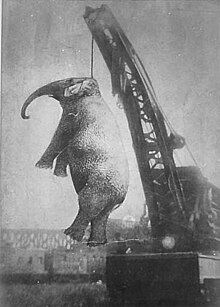 A photograph, purportedly of Mary's execution in 1916. The authenticity of this photo has been called into question. | |
| Species | Asian elephant |
|---|---|
| Sex | Female |
| Born | 1894 |
| Died | September 13, 1916 (aged 21–22) Erwin, Tennessee |
| Nation from | United States |
| Occupation | Circus performer |
| Employer | Charlie Sparks |
| Years active | 1898–1916 |
| Training | Playing musical instruments Pitching baseballs |
| Weight | 5 short tons (4,500 kg) |
| Height | 11 ft 9 in (3.58 m) |
Mary (c. 1894–September 13, 1916), also known as "Murderous Mary",[1] was a five-ton Asian elephant[2] who performed in the Sparks World Famous Shows circus. After killing circus employee Walter “Red” Eldridge on his second day as her handler in September 1916, in Kingsport, Tennessee, she was hanged in nearby Erwin.
On September 11, 1916, a homeless man named Red Eldridge, who landed a job as a transient hotel clerk,[3] was hired as an elephant keeper by the Sparks World Famous Shows circus. He was killed by Mary in Sullivan County, Tennessee, on the following evening. Although unqualified, Eldridge led the elephant parade, riding atop Mary's back; Mary was the star of the show, walking at the front.[4] There have been several accounts of his death. One, recounted by W. H. Coleman, who claimed to be a witness, is that he prodded her behind the ear with a hook after she reached down to nibble on a watermelon rind. She went into a rage, snatched Eldridge with her trunk, threw him against a drink stand and stepped on his head, crushing it.[3]
A contemporary newspaper account, from the Johnson City Staff, said that Mary "collided its trunk vice-like about [Eldridge's] body, lifted him 10 feet (3.0 m) in the air, then dashed him with fury to the ground... and with the full force of her beastly fury is said to have sunk her giant tusks entirely through his body. The animal then trampled the dying form of Eldridge as if seeking a murderous triumph, then with a sudden... swing of her massive foot hurled his body into the crowd."[3]
The details of the aftermath are confused in a maze of sensationalist newspaper stories and folklore. For example, the aforementioned newspaper account described Mary as impaling Eldridge with her tusks, despite female Asian elephants lacking tusks. Most accounts indicate that she calmed down afterwards and did not charge the onlookers, who began chanting "Kill the elephant! Let's kill it." Within minutes, local blacksmith Hench Cox tried to kill Mary, firing five rounds with little effect.[3] Meanwhile, the leaders of several nearby towns threatened not to allow the circus to visit if Mary was included. The circus owner, Charlie Sparks, reluctantly decided that the only way to quickly resolve the potentially ruinous situation was to kill the wounded elephant in public. On the following day, a foggy and rainy September 13, 1916, Mary was transported by rail to Unicoi County, Tennessee, where a crowd of over 2,500 people (including most of the town's children) assembled in the Clinchfield Railroad yard.
The elephant was hanged by the neck from a railcar-mounted industrial derrick between four o'clock and five o'clock that afternoon.[5] The first attempt resulted in a snapped chain, causing Mary to fall and break her hip as dozens of children fled in terror. The severely wounded elephant died during a second attempt and was buried beside the tracks. A veterinarian examined Mary after the hanging and determined that she had a severely infected tooth in the precise spot where Red Eldridge had prodded her.[6] The authenticity of a widely distributed (and heavily retouched) photo of her death was disputed years later by Argosy magazine.[3]